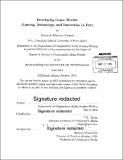Developing game worlds : gaming, technology, and innovation in Peru
Author(s)
Marisca Alvarez, Eduardo
DownloadFull printable version (18.87Mb)
Alternative title
Gaming, technology, and innovation in Peru
Other Contributors
Massachusetts Institute of Technology. Department of Comparative Media Studies.
Advisor
T.L. Taylor.
Terms of use
Metadata
Show full item recordAbstract
In this work, I've documented the origins, growth and structure of the Peruvian video game industry. Because of its underground origins, the Peruvian game industry provides an alternative, more organic gateway to developing technology industries than forms of the "technological sublime" that have been recurrent over Peruvian technological history. Driven by creative rather than commercial objectives, people interested in game development figure out ways to get around gaps in existing training options to acquire the interdisciplinary skills they need to create games - setting up alternative infrastructures to connect to each other, share information, and set up collaborations. Peruvian developers are also experimenting with ways to gain access to global networks and markets, which affects their design decisions and how they present themselves to peers and customers around the world. Games designed to present local cultural elements for international audiences - which I've called "borderland games" - have become sites where tension around self-presentation gets played out. Game studios are experimenting with various configurations of business practices, figuring out empirically what arrangements put them on the better path to engage international partners and secure creative and financial sustainability. Studios are collaborating with each other to address structural barriers affecting the industry as a whole, which is putting them in a stronger position to engage government agencies and gain support to address structural issues. This relatively unknown industry has been able to introduce complex skills and work around structural gaps and obstacles to create the foundations for a potentially viable technology and creative industry. How, exactly, the industry will develop remains to be seen, but its evolution can provide interesting lessons for the emergence of digital creative industries in developing economies.
Description
Thesis: S.M., Massachusetts Institute of Technology, Department of Comparative Media Studies, 2014. Cataloged from PDF version of thesis. Includes bibliographical references (pages 229-248).
Date issued
2014Department
Massachusetts Institute of Technology. Program in Comparative Media Studies/WritingPublisher
Massachusetts Institute of Technology
Keywords
Comparative Media Studies.